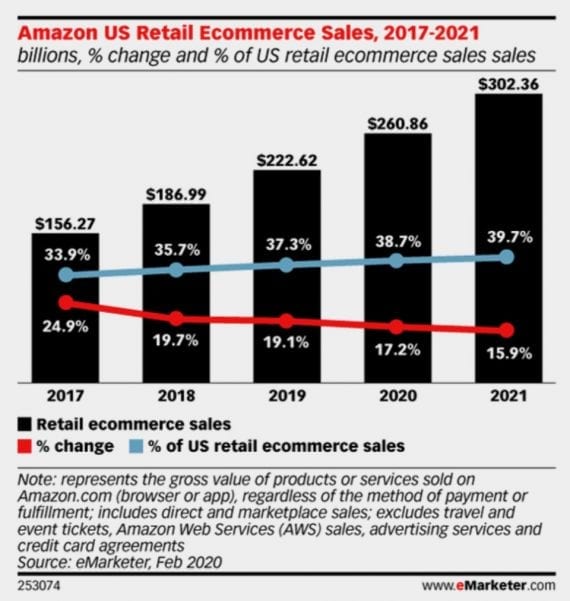On April 30 Amazon announced its 2020 first-quarter results. As anticipated, total earnings for the three months ended March 31 were exceptionally strong — about $33 million an hour in sales.
Financials
Revenue increased, but net income decreased year-over-year, with the company attributing that drop to increased product acquisition costs and soaring shipping costs. Fulfillment costs rose by more than 34 percent year-over-year to $11.5 billion, and cost of sales grew by 30.5 percent to $44.3 billion.
Amazon’s net sales of $75.5 billion were up 26 percent over the first quarter of last year, but net operating income decreased by 10 percent — $4 billion vs. $4.4 billion in the same quarter of 2019. Net income (operating income less non-operating expenses, such as interest and taxes) took a deeper dive, down 29 percent to $2.5 billion from $3.6 billion during the same period last year.
North American sales increased 29 percent to $46.1 billion; operating income was down 43 percent year-over-year. International sales increased by 18 percent, but the segment suffered an operating loss of $398 million. Amazon has experienced operating losses in this segment for the past five quarters.
Lawsuits
Amazon has garnered attention from the U.S. government, which accused Amazon of knowingly selling counterfeit goods and being a monopoly. In March and April 2020, multiple class-action lawsuits were filed in the United States and Canada against Amazon. The complaints allege a price-fixing arrangement between Amazon and third-party sellers as well as actual and attempted monopolization of an online retail market or submarkets.
Hiring
With most companies laying off workers, Amazon was one of the few bright spots in terms of employment. In March and April it hired a staggering 175,000 full-time and part-time workers to keep pace with orders. Most of these are warehouse positions. Amazon is providing one of the few alternative income sources for those who have been laid off from other jobs. This hiring may temper some of the negative publicity.
… Amazon was one of the few bright spots in terms of employment.
Second Quarter
In its March 31 10Q report to the U.S. Securities and Exchange Commission, Amazon stated:
We expect to continue to be affected by procurement and shipping delays, supply chain interruptions, higher product demand in certain categories, lower product demand in other categories, our ability to collect accounts receivable, and increased fulfillment costs and cost of sales as a percentage of net sales through at least Q2 2020…
In the April 30 earnings conference call, CEO Jeff Bezos warned, “If you’re a shareowner in Amazon, you may want to take a seat, because we’re not thinking small. Under normal circumstances, in this coming Q2, we’d expect to make some $4 billion or more in operating profit. But these aren’t normal circumstances. Instead, we expect to spend the entirety of that $4 billion, and perhaps a bit more, on Covid-related expenses getting products to customers and keeping employees safe.”
Bezos said the company plans to invest in a range of services, including “personal protective equipment, enhanced cleaning of our facilities, less efficient process paths that better allow for effective social distancing, higher wages for hourly teams, and hundreds of millions to develop our own Covid-19 testing capabilities.” In the U.S., most workers have received a $2 an hour wage increase. European workers are receiving larger pay hikes.
Those costs could contribute to an operating loss of up to $1.5 billion in the second quarter, according to Amazon’s guidance.
Despite its promises to protect workers, Amazon is giving mixed signals. On May 1, the company ended its policy of unlimited unpaid time off. Warehouse workers across the U.S. and Europe have staged walkouts, claiming the company does not provide adequate worker protection. Amazon, which has an uncompromising anti-union position, has fired some of the walkout leaders.
Amazon’s Dominance
Even before the Covid-19 outbreak, eMarketer forecasted that Amazon’s 2020 U.S. ecommerce sales would rise 17.2 percent to $261 billion — four percentage points higher than the expected overall growth rate for U.S. ecommerce sales. As a result, eMarketer projected that Amazon’s market share would increase from 37.3 percent in 2019 to 38.7 percent in 2020.

Before the pandemic, eMarketer projected that Amazon’s share of U.S. ecommerce sales would increase from 37.3 percent in 2019 to 38.7 percent in 2020.
With the pandemic-related closures of brick-and-mortar stores and the likelihood that some will not reopen, Amazon will pick up much of the retail slack. In short, Amazon is well-positioned to come out on top in the Covid-19 pandemic, even if it suffers operating losses in the short-term.
May 7, 2020 at 08:57AM
via https//www.brucedayne.com/
Marcia Kaplan, Khareem Sudlow
